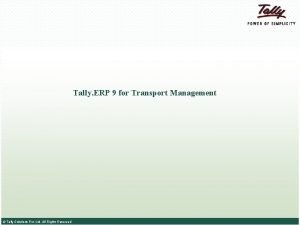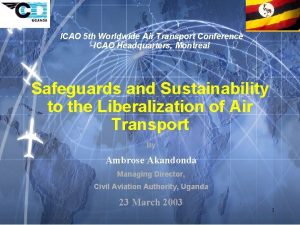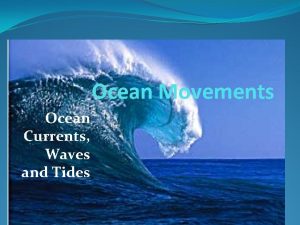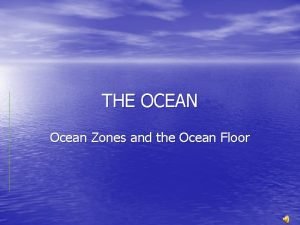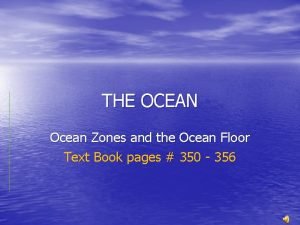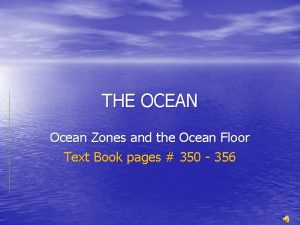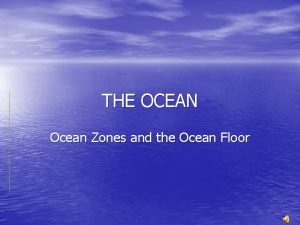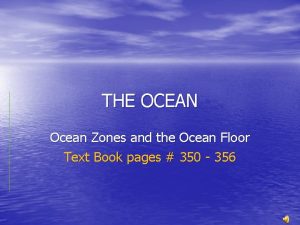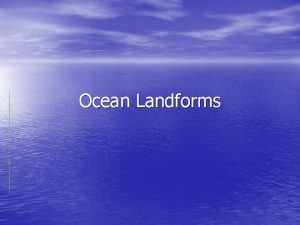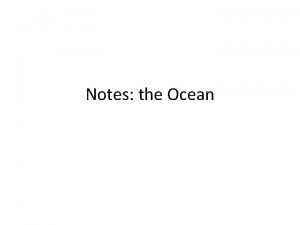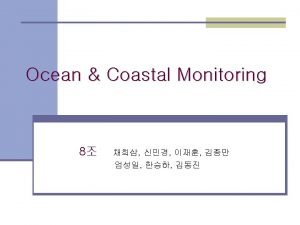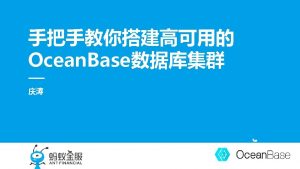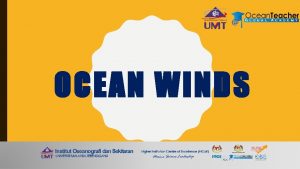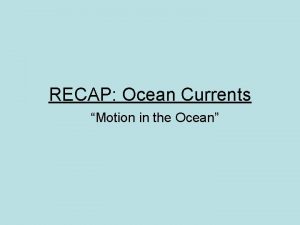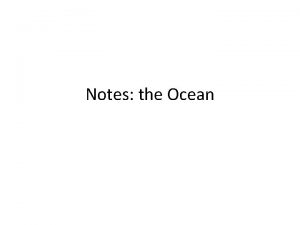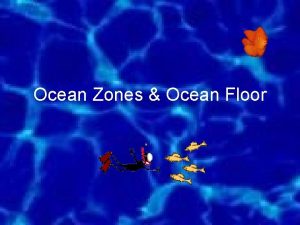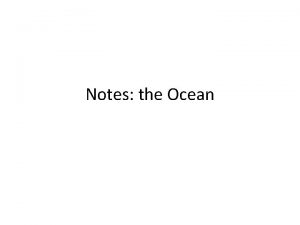Module IV Air Ocean Transport and Chartering Module
























- Slides: 24

Module IV: Air & Ocean Transport and Chartering

Module IV: Air & Ocean Transport and Chartering o o o o The General Structure of shipping industry, Characteristics of Shipping Industry, Liner and Tramp Operations and Significance, World Seaborne Trade and World Shipping, Composition of World Seaborne Trade, Liner Freighting Practice, Principles – Freight Structure, Voyage Charter, Time Charter, Problems of Shipping Industry, Shipping Policy, International Air Transport System, Air Freight Rates, India’s Export – Import Trade by Air, Problems and Prospects, Law Relating to Carriage of Goods

Shipping: o o Shipping is a global service industry that by general acknowledgement provides the lifeline of international trade. Suffice it to say that, due to the morphology of our planet, 90% of international trade takes place by sea. Technological developments in ship design and construction, and the ensuing economies of scale of larger ships, have also promoted trade – particularly those of developing countries – by making economical the transportation of goods over long distances. This has expanded markets for raw materials and final products and has facilitated the industrialization of many countries around the world.

Shipping Industry: Sectors Traditionally, the shipping industry is categorized in two major sectors (markets): 1. The bulk shipping sector – engaged mainly in the transportation of raw materials such as oil, coal, iron ore and grains – and 2. The liner shipping sector (involved in the transportation of final and semi-final products such as computers, textiles and a miscellany of manufacturing output).

Types of Ships

Various Ships--Tankers Aframax ULCC LNG VLCC

Difference Bulk & Linear Shipping: From a market structure point of view, the two sectors are as different as they could be o o o Bulk shipping uses large and unsophisticated ships, such as tankers and bulk-carriers, to transport goods in bulk on a contract basis. The service requires minimal infrastructure, and in this respect, it resembles a taxi service whereby the contractual relation between passenger and driver (cargo owner and ship owner) expires upon the completion of the trip. The industry is highly competitive with prices (freight rates) fluctuating wildly even in the course of a single week.

Drivers in the Shipping industry The primary demand supply driver in the shipping industry is freight rates, which determines the revenue of shipping companies. Other drivers of the shipping industry are: o Trade growth o Geographical concentration of trade o Threat of wars, piracy, storms and hurricanes o Government sanctions on shipment o Access to and suitability of other modes of shipment The supply drivers of the industry include: o Demand for oil and dry bulk o Climatic conditions (rains, storms and tides) o Government restrictions on shipment o

Difference between a Liner shipping service and Tramp : Some of you might have heard the terminology Tramp service or Tramper or Tramp vessel and also the terminology Liner Service. . What is the difference between the two. . ? ? o Liner Service – is a service that operates within a schedule and has a fixed port rotation with published dates of calls at the advertised ports. . A liner service generally fulfills the schedule unless in cases where a call at one of the ports has been unduly delayed due to natural or man-mad causes. . Example : The UK/NWC continent service of MSC which has a fixed weekly schedule calling the South African ports of Durban, Cape Town and Port Elizabeth and carrying cargo to the UK/NWC ports of Felixstowe, Antwerp, Hamburg, Le Havre and Rotterdam. . o A Tramp Service or tramper on the other hand is a ship that has no fixed routing or itinerary or schedule and is available at short notice (or fixture) to load any cargo from any port to any port. . Example : A ship that arrives at Durban from Korea to discharge cargo might carry some other cargo from Durban to the Oakland in the West Coast of USA which in an entirely different direction. . From Oakland say for example it could carry some cargo and go to Bremerhaven o

World Seaborne Trade and World Shipping,

Seaborne trade: o o Seaborne trade continues to expand, bringing benefits for consumers across the world through competitive freight costs. Thanks to the growing efficiency of shipping as a mode of transport and increased economic liberalisation, the prospects for the industry's further growth continue to be strong. There are over 50, 000 merchant ships trading internationally, transporting every kind of cargo. The world fleet is registered in over 150 nations, and manned by over a million seafarers of virtually every nationality.

Large Loads: n n As time progresses, so does the size, science and structure of ships. Today, they are relied upon for an assortment of tasks that still cannot be done as successfully through other means. The primary advantage of ships is their ability to carry tons of merchandise and equipment. They transport many of the world's finite resources, including oil and coal.

Low Cost n The secondary advantage of liners and tramps is their low cost. Transporting goods across the sea is much cheaper than carrying them through the air, mostly due to the massive quantities that can be delivered at once with a tramp or liner. Shipping via air cargo would require several planes --- costing much more in fuel --- to equal the load of a ship.

Time: n n n Unfortunately, liners and tramps have disadvantages too. Although ships are better than planes for cargo loading, they are much slower than airplanes. Liners and tramps can travel for days and even weeks to deliver cargo. In many industries where time is of the essence, this can be a central issue. Although rare, problems with sinking or crashes can occur. Tankers that carry oil can cause a significant environmental impact if a catastrophic event takes place

Advantages & Disadvantages of Liners & Tramps : o o o With all the different types of transportation, shipping still remains one of the top methods. Shipping can be arranged either through a regular liner or through tramp services, which do not have a fixed schedule. Able to suit different needs and functions, these two services have long been the lifeblood of the vast transportation market. Liners carry goods in large quantities from merchants and consigners. Tramp ships, on the other hand, often carry cargo on a more random, per-load basis.

Composition of World Seaborne Trade: sea trade. pdf

o o Marini time shipping. pdf rmt 2011_en. pdf

What Is Chartering ? Chartering/Shipping is an activity within the shipping industry. In some cases a charterer may own cargo and employ a shipbroker to find a ship to deliver the cargo for a certain price, called freight rate Two types of charter: 1. Voyage charter 2. Time charter o

Voyage charter: There are many different reasons which influence a charterer's decision as to whether to charter on a voyage basis or to take ships on time charter. o advantage Voyage charter gives the charterer a fixed price per ton of material and passes almost all the risks, especially risks of delays due to bad weather, strikes etc onto the shoulders of the shipowner. The charterer does, however, have to pay for the privilege of being risk-free. o

Time Charter: advantage o Time charter gives the charterer considerable flexibility as to where to send the ship and is spared the problems of demurrage. o Time charter does, however, mean that if bad weather delays the ship or if workers in a chosen port decide to strike, the daily rate of hire still has to be paid.

Choosing voyage or time charter o o o Thus, if the charterer has a single commodity from one or a limited number of loading places to go to a single or limited number of discharging places, and the rates of loading and discharging are well established, then voyage charter is the obvious choice. If, however, the charterer has many different commodities from/to a variety of places so complex that it would be difficult if not impossible to include them all in a voyage charter, then time charter is a better idea. This is typified by time charter on a 'trip' basis where one could well see the business being quoted "Delivery Kobe, trip across Far East/West Coast North America redelivery Los Angeles - Vancouver Range expected duration 90 days" Another regular reason for time chartering is when a liner company seeks temporarily to supplement its own fleet in order to cope with a seasonal increase in business. Time charter is often regularly used by container lines to cater for their 'feeder' business and there is a whole segment of the market devoted to relatively small container ships to fill the requirements of the feeder industry.

Law Relating to Carriage of Goods o o In the commercial life of any country, the need for carrying goods from one place to another cannot be over emphasised. Also, goods are to be moved from one country to another. For these purposes, a contract of carriage is to be entered into. The persons, organisations or associations which carry goods are known as carriers. Goods may be carried by land (including inland waterways), sea or air. Accordingly, the law relating to carrying of goods is contained in the following enactments: 1. In case of carriage of goods by land: (i) The Carriers Act, 1865. (ii) The Railways Act, 1989. 2. In case of carriage of goods by sea: (i) The (Indian) Bills of Landing Act, 1856. (ii) The Carriage of Goods by Sea Act, 1925. (iii) The Merchant Shipping Act, 1958. (iv) The Marine Insurance Act, 1963. 3. In the case of carriage of goods by air: The Carriage by Air Act, 1972.

The law relating to carrying of goods is contained in the following enactments: o 1. In case of carriage of goods by land: (i) The Carriers Act, 1865. (ii) The Railways Act, 1989. o 2. In case of carriage of goods by sea: (i) The (Indian) Bills of Landing Act, 1856. (ii) The Carriage of Goods by Sea Act, 1925. (iii) The Merchant Shipping Act, 1958. (iv) The Marine Insurance Act, 1963. o 3. In the case of carriage of goods by air: The Carriage by Air Act, 1972

o o Law of Carriage of Goods. mht. . MKTThe Rotterdam Rules_ A practical annotation. flv
 Liner vs tramp
Liner vs tramp Texas 4-h chartering
Texas 4-h chartering Ship chartering courses
Ship chartering courses Chapter 15 ocean water and ocean life answer key
Chapter 15 ocean water and ocean life answer key Hubungan air dengan tanah
Hubungan air dengan tanah Convergent vs divergent boundaries
Convergent vs divergent boundaries Ocean ocean convergent boundary
Ocean ocean convergent boundary Convergent boundary
Convergent boundary Ocean ocean convergent boundary
Ocean ocean convergent boundary Convergent continental boundary
Convergent continental boundary Convergent oceanic oceanic plate boundary
Convergent oceanic oceanic plate boundary Red ocean strategi
Red ocean strategi Sodium potasium pump
Sodium potasium pump Active transport
Active transport What is passive transport
What is passive transport Now answer the questions
Now answer the questions Passive transport vs active transport venn diagram
Passive transport vs active transport venn diagram Endocytosis vs exocytosis
Endocytosis vs exocytosis Primary active transport vs secondary active transport
Primary active transport vs secondary active transport Bioflix activity membrane transport active transport
Bioflix activity membrane transport active transport Isotonic in biology
Isotonic in biology Transport module in tally
Transport module in tally Optical transport module
Optical transport module Trame sdh
Trame sdh Air transport conference
Air transport conference





















